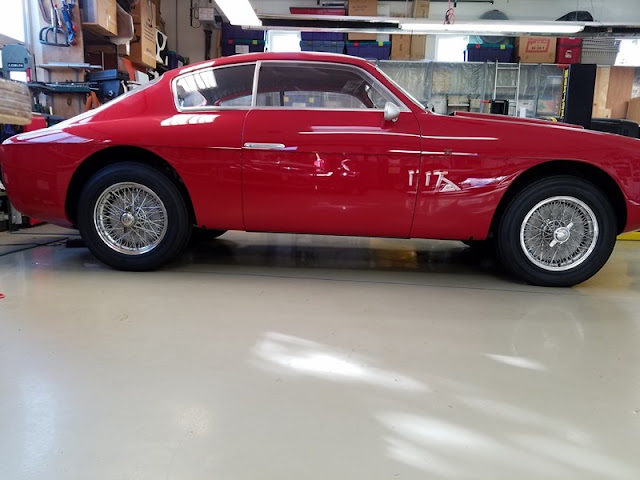This exploded diagram of a 1900 Alfa's rear suspension from the official Alfa Model 1900 Parts Catalog solved a mystery, saved me a lot of trouble, and once again proved that you cannot take too many photos or make too many sketches when you are in the disassembly phase.
I took The Alfatross' rear suspension apart about 25 years ago when I still had not learned that lesson. I bagged all the parts and labeled them but--digital photography being at that time not even a glimmer in anyone's eye--did not have the means to photograph everything in its original location on the car.
When I reassembled the rear suspension about 18 months ago I re-used almost all the original cleaned and restored parts except for the drop stop straps. The originals were made of some kind of fibrous material that was worn, frayed, tattered, and unsafe so I replaced them with widely available new reproductions that come with neatly cut holes ready to install.
All I had to do was bolt the straps to the chassis under the big rubber bump stops, wrap them around the axle, and connect the ends. Among the rear suspension parts I had two small steel plates with holes matching the spacing on the straps, but mistakenly assumed [Mistake No. 1: don't assume anything. Spend the time necessary to think it through.] that the straps were supposed to be secured end-to-end, which would mean that I was really supposed to have four little plates, not just two [Mistake No. 2: The more assumptions you have to make, the more unlikely an explanation is.] So I cut and drilled two steel attachment pieces, each with four holes to fill that function--and thought I was being very resourceful.
 |
| The "over-improved" drop stops utilizing fabricated plates to connect the strap end- to-end instead of overlapping. The result of a failure to apply Occam's Razor. |
 |
| The drop stop clamp plates. Note the distinctive ridges along the edges. |
While replacing the rear suspension springs in order to lower the ride height I had occasion to look at the exploded diagram in the Parts Catalog again. This time, I noticed the small window in the upper right corner showing all the parts for both the drop- and bump-stops and finally realized that I had the right parts all along, I just wasn't putting them together right! Not only that, I went to a lot of unnecessary trouble to do it all wrong!
Correcting this seemingly small mistake shortens the strap length and reduces the distance the rear axle can move downward by more than an inch. I am sure the Alfa engineers who designed the suspension system set the drop stop distance where it is for a reason, and allowing the rear axle to move an inch or more downward could cause damage to other components under certain circumstances, so I am relieved to correct this mistake in time. It also means that the exhaust system can be attached an inch closer to the chassis.
 |
| Correct attachment with strap ends overlapping and held together with 10 mm bolts passing through the steel clamp plate, straps, washers, and secured with nuts. |
So now, having removed or detached, replaced or reconnected the fuel pump, fuel lines, brake lines, emergency brake lines, axle supports, drive shaft, rear springs and drop stops in order to get the ride height sorted out . . . I can finally get back to where I was a month ago: attaching the new exhaust system.








